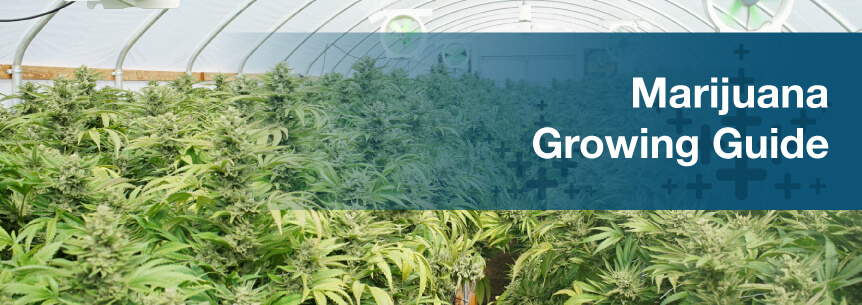
Many medical marijuana patients get their medicine from a dispensary, but what if you don’t have a dispensary nearby, or you can’t find the medicine you need? You might also rather just do things yourself. In some parts of the United States, you can grow your own medical marijuana to solve these issues.
Some people want to join the medical marijuana industry by growing plants for making medicine. Whether you start your own business or work for an existing one, you can take advantage of the United States’ cannabis boom. You can also help enhance the lives of patients looking for natural relief.
In this medicinal weed growing guide, you will learn:
Since cannabis laws vary from state to state, you should look at your state laws and regulations to understand what you can legally do. Make sure to support your learning here with our information on medical marijuana state laws.
Growing medical cannabis isn’t quite as simple as putting a seed in a pot and getting marijuana. It takes time, effort and money. Plus, state and federal regulations could affect what you can and can’t do when you grow it. So, when thinking about growing your own medicine, ask yourself the following questions:
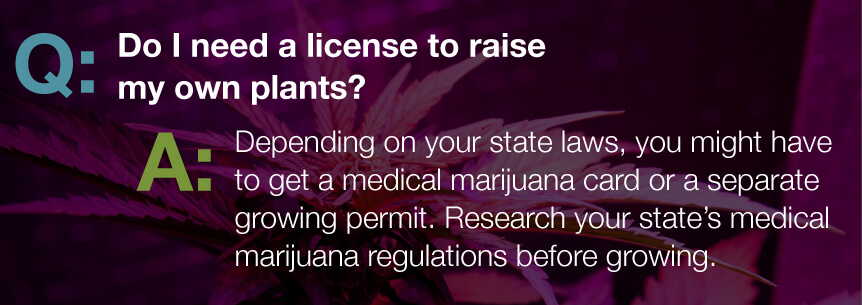
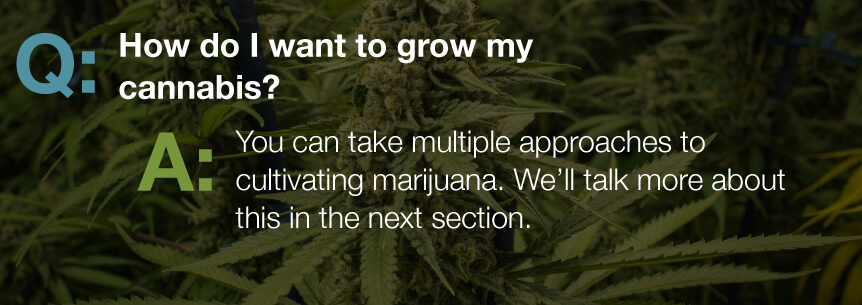
Creating your own medical cannabis garden definitely has its perks, but you should keep the potential drawbacks in mind. Since medical marijuana is such a new frontier in the United States, aspiring growers have some accessibility and legal issues to face. If you don’t mind the possible issues, though, you can reap the immense benefits of growing your own medicine.

Raising marijuana plants can be a highly rewarding experience. Some of the perks of having a cannabis garden include:
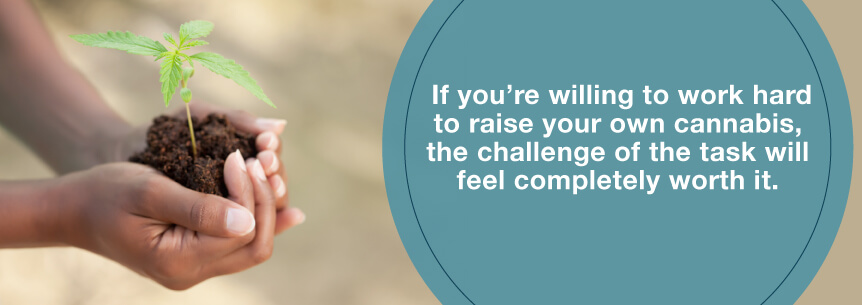
But, growing cannabis can have its difficulties as well. Some drawbacks to consider include:
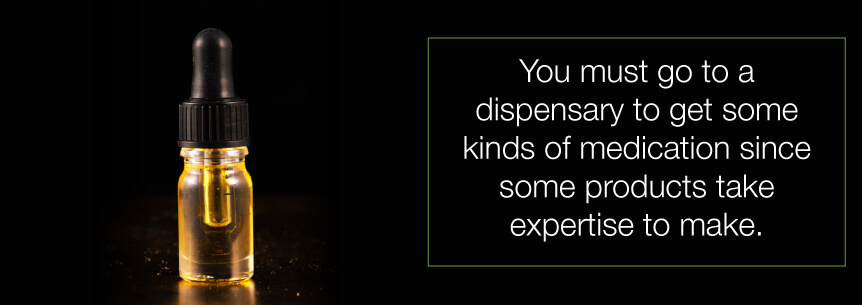
As you can see, you have a lot to think about before you start growing medical marijuana. But, everything has its pros and cons, and you might find that the drawbacks are worth the benefits.
Just like growing other plants, you can raise marijuana using a wide variety of methods. When thinking about how you will cultivate your cannabis, you must consider two factors — the growing medium and the grow light. In other words, you have to decide what you will grow your plants in and the light you will use to help them grow.
The medium that will work best for you and your crop will depend on your individual circumstances and gardening experience. There are five different mediums for raising cannabis:
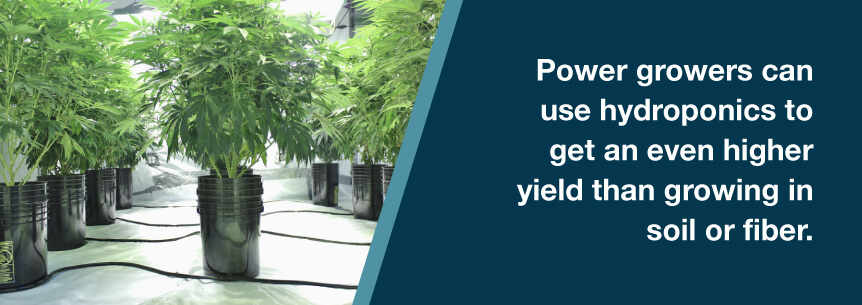
If you decide to use soil or fiber, you should also get the right container. People who only want to grow a small plant can simply use a five-gallon bucket with holes drilled in the bottom or a big gardening pot. Make sure your container will let your medium drain any extra water.
Hydroponics, aeroponics and aquaculture involve specialized equipment that experienced gardeners and professional businesses might use. If you’re just starting out, you should really think about the cost and work involved in these methods. While they take more money and time, though, they also let you take advantage of a much higher quality.
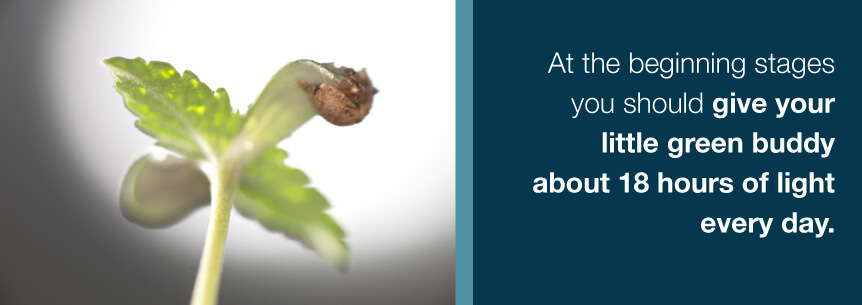
Once you pick a home for your cannabis, you have to choose the kind of lighting you will use. No matter how you grow your cannabis, you must give it plenty of light. In fact, marijuana should get about 18 hours of light per day! You have the choice of the following types of lights:
Do you have your medium and light picked out? Great — now, all you have to do is pick the marijuana strain you want to grow. You can find seeds online or ask your local dispensary where you can legally get some in-person.
Like other plants, marijuana comes in different kinds of plants. Think of the seed packets for flowers and vegetables you find at the garden store. There aren’t just seeds for a plant like “tomatoes.” Instead, they come in varieties like “heirloom tomatoes.” It works similarly for marijuana, and each type has specialized health benefits.
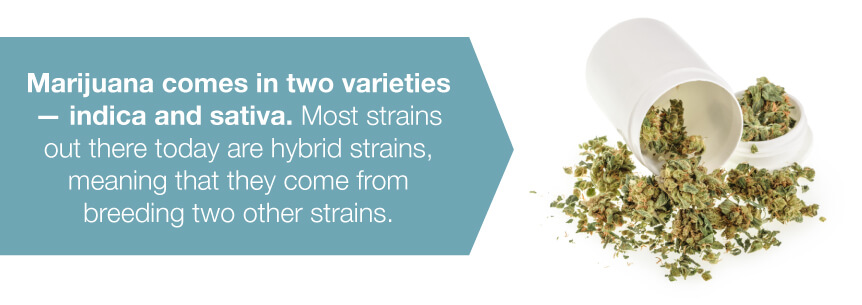
Marijuana comes in two varieties — indica and sativa. Most strains out there today are hybrid strains, meaning that they come from breeding two other strains. Hybrid strains can have indica-indica parents, sativa-sativa parents or indica-sativa parents.
Patients use indica strains to relax and feel full-body benefits, and they use sativa strains for cerebral effects and mood enhancement. Hybrid strains bred from an indica strain and a sativa strain can combine the benefits of both. Talk with your doctor and budtender about what strain will work best for your medical issues.
Now that you have all the supplies you need, you can start getting your green thumb on. Gather all your materials and get ready to plant and sprout your seeds. Once you have your cannabis planted, you can get to the main part of the growing process.
Once your pot is full of soil or fiber, you can plant your cannabis seed about one-half to one inch deep. Keep the soil moist and put the pot somewhere warm. Eventually, your plant will produce a small sprout, and then it will form recognizable marijuana leaves.
When you have the beginnings of a bonafide marijuana plant, you can focus on light. When your cannabis gets plenty of light every day, it will enter the vegetation state, where it will grow larger and stronger. Give your little green buddy about 18 hours of light every day.
While your marijuana grows, you should also regularly give it fertilizer. Use a product that suits cannabis plants’ needs. You might want to ask your seed provider or another marijuana professional about the best fertilizer to use.
Once your plant becomes as big as you want it to grow to, you can start to give it less light. Instead of 18 hours, give it 12 hours a day. The reduced light will trigger flowering and fruiting, letting buds form.
Experienced growers can try their hand at advanced methods like hydroponics, aeroponics or aquaculture. If you want to give it a shot, consult with gardening experts. For specific advice on marijuana, you can try contacting the business you bought your seeds from to find someone who knows their stuff.
Whichever approach you take, you can dry your bud for use. Cut the buds off the plant, and remove big leaves or stems. Hang your crops up to dry. Once the small stems snap but the large stems bend, you have the right level of dryness. Put your bud in a Mason jar and keep it in a dark place to let it cure.
Folks growing medical marijuana and people who grow recreationally have a few different things to consider, but they’re more similar than you think. A lot of the differences lie in regulations and availability.
Raising cannabis for medical and recreational purposes work the same way. You can use the methods mentioned in this guide to growing marijuana for any reason. No matter what you use your cannabis for, you want the same level of quality.
Medical marijuana and recreational marijuana plants are the same. When we call cannabis “medical” or “recreational,” we talk about why someone uses it, not its physical qualities. We mostly use those terms to refer to the regulations surrounding each kind of use.
However, depending on where you live, you may only have the ability to grow your plants for medical purposes. States that ban recreational use also prohibit growing marijuana recreationally. If you live somewhere that allows recreational marijuana, you might already have the authorization you need to grow your own plants. Be sure to follow any state laws and regulations, though, and know for sure what permission you need to cultivate your own plants.
Commercial growers may have to follow different standards for medical marijuana and recreational marijuana cultivation. Depending on what products and medicine are allowed in their state, they may have to grow their plants to ensure a quality end product. And, of course, growing regulations vary from state to state, whether they allow recreational marijuana or not.
Whether you want to grow your own medical marijuana or become a professional grower, you’re in good company. Check out these facts about the cannabis industry:

Despite these statistics, marijuana remains illegal on a federal level, and the future status of the industry is uncertain. Industry professionals worry about the Donald Trump administration’s stance on cannabis, but they also have hope that the industry’s potential will give them a chance. His focus on business and economic progress could take priority over his conservative values.
As medical marijuana’s economic power grows, so does the health industry. While jobs in government, utilities and manufacturing decline, healthcare-related professions keep expanding. This trend not only implies that the healthcare industry helps medical marijuana sales, but that medical marijuana sales help the healthcare industry.
When you grow medical marijuana for business, you don’t just provide plants to the industry. You give businesses the resources to make many kinds of medicine for patients in need. They can sell the bud from your plants as-is, or they can make it into concentrates, edibles and more. Some of the newest kinds of medical marijuana products include:

In addition to expanding their product selection, cannabis entrepreneurs currently focus on enhancing quality and safety. By increasing quality testing and banning certain chemicals, they create purer medication than ever. Whether due to new regulations or a commitment to quality, a growing facility might allow only specific kinds of cultivation methods.
As our country’s viewpoint of medical cannabis becomes more accepting, the industry will have even more room to develop. More and more states are legalizing medical and recreational marijuana, providing more business opportunities for budding entrepreneurs.
Professional and personal cannabis growing differ in a few ways you should keep in mind. If you want to become a professional grower for dispensaries, you have a lot more to do than a personal grower.
Mainly, you should consider how many more regulations you must follow when you grow marijuana professionally. Both personal and professional growers have to follow many laws and policies, but professional growers cultivate plants that other people will use, so many states will impose even more regulations to ensure safety.
The most important regulation to follow is to get the proper authorization from the government. If you want to start your own marijuana business, you must get a license. On the other hand, personal growers may not need a license at all. We’ll talk more about businesses and licenses in just a bit.
Compared to personal growers, professional growers have to spend a lot more time and money if they want to start their own operation. Growing a few plants for yourself can cost a lot, let alone gardening on a larger scale! And raising more plants means dedicating more time to them.
If you want to work for someone else, you still have more factors to consider than a personal grower. Folks who want to join an existing business as a grower might have to go through certification to do their jobs. Additionally, you have to go through the job search process and complete any onboarding.
Like any other skilled profession, marijuana cultivation takes the right skills, training and dedication. We talked earlier about the power of the marijuana industry. Even though many folks imagine cannabis cultivation as something that only “stoners” do in their basements, it can actually offer a fulfilling career path. And while becoming a professional grower takes a few unique measures, it can be similar to getting any other cultivation job.
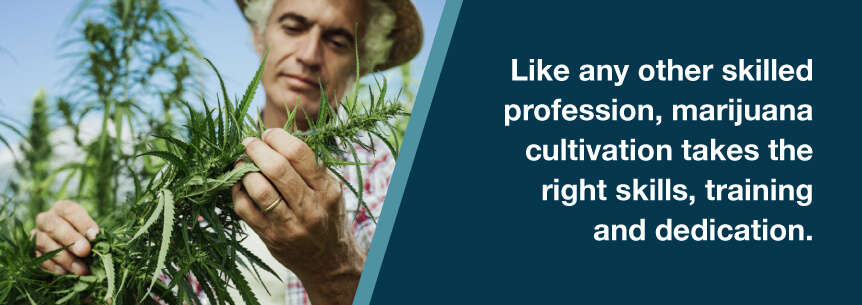
A good cannabis entrepreneur has the proper experience to do their job well. Folks who want to start a business from scratch should have training and experience in ownership and management. It would also help if they understood at least the basics of growing medical marijuana commercially.
Depending on the business’ policies, employees may need extensive qualifications, too. People who want to work as a grower for an already existing operation should have experience and training in growing. If you already have extensive experience raising marijuana plants professionally, you might not need a degree to get hired, but if you have no prior experience, a degree in horticulture or botany could give you an advantage.
A growing license is an official authorization from the government to cultivate marijuana. Just like how a driver’s license lets you legally drive, a growing license lets you legally grow cannabis. Folks who want to grow marijuana on a large scale must have a license to obey the law.
Whether you need a license to raise marijuana plants depends on what you intend to do with them. To grow cannabis professionally, you must have a growing license from the state. Patients usually just need a medical marijuana card as long as they plan to grow a number of plants below the legal limit. In some states, you can grow cannabis recreationally, meaning you have authorization as long as you’re a legal adult.
To get a license, you have to register for one through the proper government department. Some states require you to register through a specialized medical marijuana department. Others include marijuana-related regulations and licensing in their drug and alcohol department or health department. You might have to sign up in person, but some states may allow online registration.
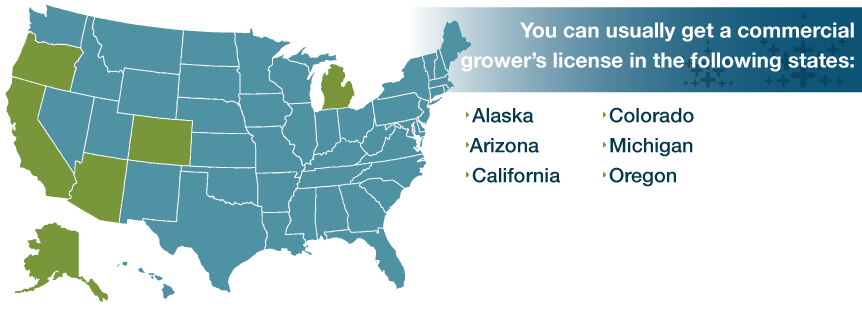
You can usually get a commercial grower’s license in the following states:
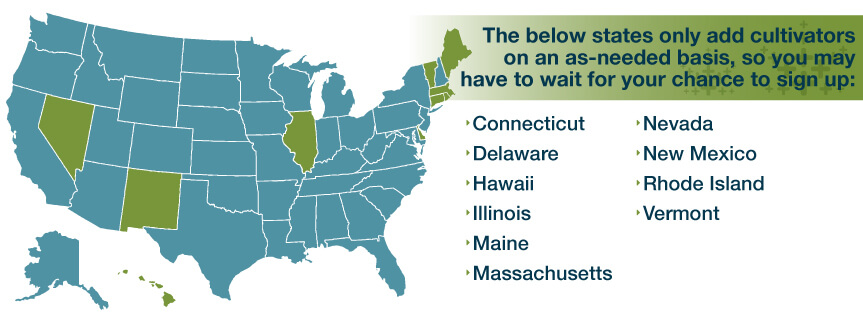
The below states only add cultivators on an as-needed basis, so you may have to wait for your chance to sign up:
The following states don’t offer growing licenses at the time of writing:
If you have to have a medical marijuana patient or caregiver license to grow, you should register with your state accordingly. Some states make it simple to sign up, while others involve more steps. To learn how to register where you live, check out our registration guides for each state.
Patients and caretakers can grow their own medical cannabis in the following states:
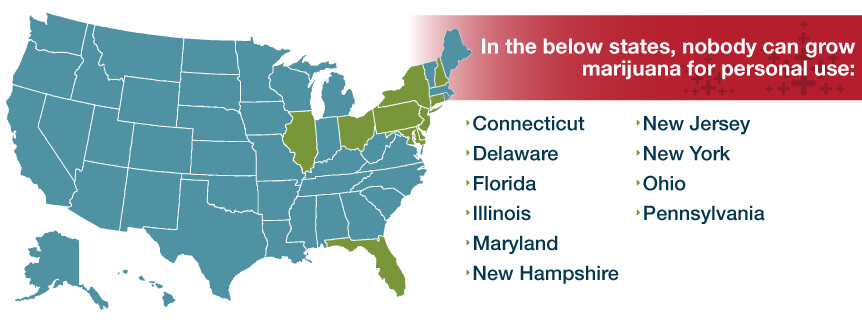
In the below states, nobody can grow marijuana for personal use:
In the future, each state’s availability of cultivation licenses may change. States may change regulations for at-home growing, too. For the latest updates on state cultivation laws, keep an eye on our blog.
Just like with other medical marijuana-related laws, every state has different policies on growing cannabis plants. If your state lets you grow marijuana, check below for exact limits:
Many states require you to keep your plants out of public view or a certain distance away from schools. Closely read your state’s growing policies before you decide where to keep your cannabis plants.
Here at MarijuanaDoctors.com, we aim to give you a comprehensive resource for medical marijuana doctors and patients. That means we cover numerous topics like legislation, recipes, marijuana science, news, products and more. We’ve dug up some pages from our website that you can use to further expand your knowledge on growing medical cannabis:
Some folks reading this guide need to start from step one. Are you not yet a patient and want to become one? Or, maybe you need to find a local dispensary where you can get medicine and advice. We’ve got you covered on both fronts.
Our physician listings can help you find the perfect cannabis-trained medical professional to get you certified as a patient. The dispensary database on our site includes locations in both remote and populated areas.